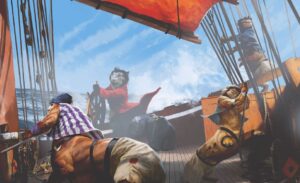
 A lot of the fun of a Star Trek adventure is the discovery of new lifeforms, seeing how they’re similar to human cultures and accepting what is alien to human culture. The Shackleton Expanse Campaign Guide introduces a new swath of the Beta Quadrant to explore, including races that have not yet made contact with the residents of the greater galaxy.
A lot of the fun of a Star Trek adventure is the discovery of new lifeforms, seeing how they’re similar to human cultures and accepting what is alien to human culture. The Shackleton Expanse Campaign Guide introduces a new swath of the Beta Quadrant to explore, including races that have not yet made contact with the residents of the greater galaxy.
Each race is detailed in the guide as a faction in the Shackleton Expanse, so they can be roleplayed as a unique culture. They are also featured in the player’s options section of the book, so they can be used as the basis of unique races playable in a campaign. The book notes the races aren’t encouraged to be used in play except in Next Generation campaigns, because the races at the earliest wouldn’t be exposed to Starfleet until 2371. Gravitational eddies and other hazards made the Shackleton Expanse too dangerous to explore in prior eras.
First, the book describes the Akaru. They are physically similar to Romulans and Vulcans, except for vestigial webbing between the fingers. The people are led by Iryax Nedalon the Ageless, who personally selects the three hundred Akaru who make up the ruling counsel, called the Akaru’bak. It’s believed Iryax performs genetic modifications on the initiates of the Akaru’bak.
Science and technology are widely promoted across the planet. The arts are supported, however plays are state-sanctioned and focus on the incomparable power and grace of Iryax. Music is diverse, however five-stringed instruments and deep percussion accompaniment are staples in the Akaru tradition.
Then, the guide mentions the Cal-Mirrans, who are water-based creatures who create their own state of matter. Cal-Mirrans are born when lightning strikes the ocean’s water under specific circumstances. Energy remains in the sample that becomes a Cal-Mirran. They can change their state of matter to solid, liquid and gas. These changes of state exhaust the Cal-Mirrans.
Most Cal-Mirrans dwell together in an area called the Circular City. Some choose to dwell distant from the majority and are known as Outliers. Many of these are devout adherents to the Sunseeker religion. They believe the sun is the source of all life and choose to present themselves as permanent spheres for this reason. These Cal-Mirrans have evolved to survive away from the optimum zone in Circular City and have evolved to be able to protect themselves against radiation.
The Cal-Mirrans live in hardened glass structures attached to the basalt pillars that appear in the depths. There are shelters above and beneath the surface, protecting the Cal-Mirrans from currents.
An interesting trait of the Cal-Mirrans is they can engage in time refraction. They’re able to transport themselves minutes, hours or days into the future. There are obvious practical effects from doing this, but Cal-Mirrans sometimes do this for entertainment value.
My favorite of the new races is the brilliant-minded Qofuari. These otter-like creatures live on the surface or on ships, such as seen in 19th century Earth. Their practical technology is not advanced, but their minds are capable of designing warp drives and super computers, with near-perfect design. However, they don’t see practical value for themselves or their world to create such technologies. A group of Qofuari called the Future Builders are young Qofuari who believe that the brilliant designs their people think of should be built. This goes against tradition and isn’t well-received by most of their society.
Finally, the guide discusses the Vinshari. These people are humanoids with blood-red skin. The males have a bone collar that emerges from between the shoulder blades and wrap around the neck. Female bone collars also begin between the shoulder blades but are vertical.
The Vinshari did not start as the dominant lifeform on their planet. In fact, they were hunted to near extinction by creatures called manis. The Vinshari were forced to evolve, developing tactics for living and fighting together against the common enemy. Then they came up with technology for defeating the manis.
With the manis threat handled, Vinshari are warp-capable and have a view their lives should be spent in conquest to benefit the Vinshari people. They captured a space creature called a Ha’Kiv that is able of producing great amounts of power and used it to power their planet. Now they travel through space looking for more Ha’Kiv to capture and use to provide power for their planet.
The Vinshari created a mighty army, composed of Enforcers, manis and The Order of the Midajah-Ka (an all-female elite force).
Vinshari families consist of three to nine people, like in the early days when large families were needed to protect themselves from the manis. Now, the idea of family includes anyone who stands by you. So, the concept of family goes beyond bloodlines to include those closest to a Vinshari. So, many relationships are based on the individual, rather than gender or sexuality.
With these diverse offerings of characters found in the Shackleton Expanse, players can either create characters with interesting backgrounds and personalities or discover new cultures to interact with and learn from.
